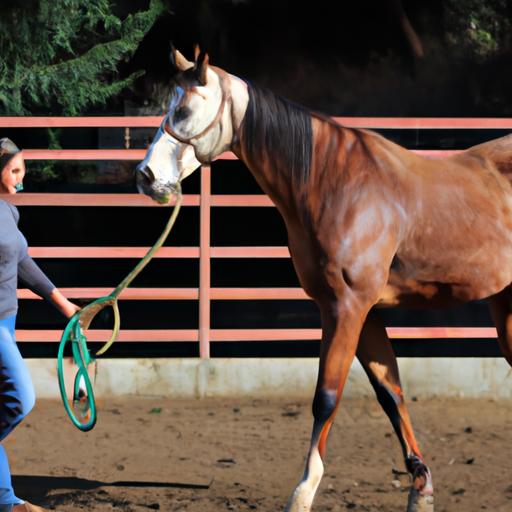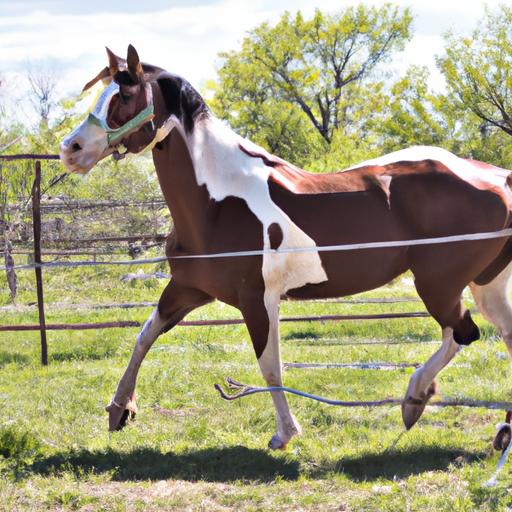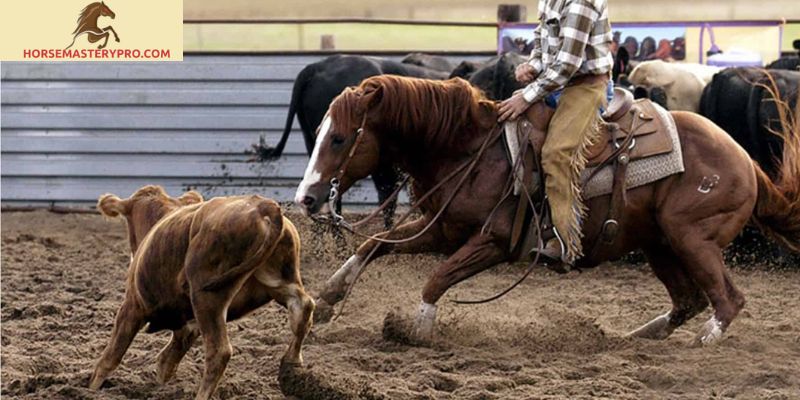Unleash the true potential of your cutting horse through effective training techniques. Discover ground manners, commands, and trust-building methods.
Introduction

When it comes to the world of equestrian sports, few disciplines captivate audiences like cutting horse competitions. The sheer agility, precision, and instinct displayed by these magnificent creatures are nothing short of awe-inspiring. However, behind every successful cutting horse lies hours of dedicated training, which is why understanding the importance of cutting horse training is crucial.
Why is Cutting Horse Training Important?
Imagine a symphony without a conductor or a puzzle missing a crucial piece. In the world of cutting horse competitions, training is the conductor, the missing piece that brings harmony and success. Cutting horse training aims to mold these incredible animals into exceptional athletes, honing their natural instincts and abilities to navigate cattle with finesse and precision.
A Brief Overview of Cutting Horse Training
At its core, cutting horse training revolves around teaching horses to separate a single cow from a herd and keep it isolated for a certain duration. This requires an intricate dance between the horse and rider, as they work together to anticipate the cow’s movements and make split-second decisions. To achieve this level of partnership, cutting horse training encompasses a range of techniques and methods that gradually shape the horse’s behavior and skillset.
In the upcoming sections, we’ll delve deeper into the world of cutting horse training, exploring the characteristics of these remarkable horses and the history behind their development. We’ll uncover the basic and advanced training techniques employed, discuss specific challenges trainers may encounter, and offer valuable tips for successful cutting horse training. So, grab your saddle and let’s embark on this exhilarating journey together!
“Are you ready to unleash the true potential of your cutting horse? Join me as we dive into the art and science of cutting horse training, discovering the secrets that separate champions from the rest of the herd.”
Understanding Cutting Horses

Characteristics and Traits of Cutting Horses
To comprehend the art of cutting horse training, it’s essential to grasp the distinctive characteristics and traits that make these horses exceptional. Cutting horses are typically agile, intelligent, and possess a keen sense of cow instinct. Their natural athleticism, quick reflexes, and ability to anticipate a cow’s movements set them apart from other equine disciplines.
Furthermore, cutting horses exhibit a remarkable level of trainability and versatility. They have a strong work ethic and an innate desire to please their riders. This willingness to learn, coupled with their inherent athleticism, makes them ideal candidates for cutting horse training.
History and Origin of Cutting Horses
The roots of cutting horse training can be traced back to the expansive ranches of the American West. Cattle ranchers needed horses with the ability to separate individual cows from the herd for various purposes, such as branding, medical treatment, or sorting. This necessity led to the development of cutting horses.
The practice of cutting cattle on horseback gained popularity in the late 19th century, with competitions emerging to showcase the skills of these exceptional horses. What was once a practical task on the ranch soon evolved into a competitive sport. Today, cutting horse competitions draw enthusiasts from around the world, marveling at the seamless harmony between horse and rider.
“As we delve into the world of cutting horse training, let’s explore the distinct characteristics that make these horses truly remarkable. Discover the rich history and origin of cutting horses, unraveling the deep connection between these magnificent creatures and the American West.”
Advanced Training Methods for Cutting Horses

As we delve deeper into the realm of cutting horse training, we encounter the advanced techniques that elevate these majestic creatures to the pinnacle of their abilities. Beyond the basics, advanced training methods focus on refining specific maneuvers, enhancing their natural instincts, and elevating their responsiveness and agility.
A. Teaching Specific Maneuvers such as Stops, Turns, and Spins
To unlock the full potential of a cutting horse, trainers must teach them a repertoire of precise maneuvers. These include sharp stops, quick turns, and lightning-fast spins. By breaking down these complex actions into smaller, manageable steps, trainers can guide their horses towards mastery. Through consistent practice and reinforcement, horses learn to execute these maneuvers seamlessly, adding finesse and flair to their performances.
B. Developing Cow Sense and Instinct in Cutting Horses
One of the fundamental aspects of cutting horse training is developing their innate cow sense and instinct. Cutting horses possess an inherent ability to anticipate the movements of cattle, enabling them to make split-second decisions during competitions. Advanced training methods involve exposing horses to various cattle scenarios, allowing them to refine their instincts and sharpen their focus. Trainers employ techniques that challenge the horse’s ability to read cattle behavior, encouraging them to become more attuned and responsive to their bovine counterparts.
C. Enhancing Responsiveness and Agility in Cutting Horses
To truly excel in cutting horse competitions, horses must possess exceptional responsiveness and agility. Advanced training methods focus on fine-tuning these attributes, pushing horses to be more agile, quick-footed, and responsive to their rider’s cues. Through exercises that emphasize lateral movements, lead changes, and precise footwork, trainers aim to enhance the horse’s overall athleticism and maneuverability. By developing a strong partnership and clear communication between horse and rider, they can achieve the seamless coordination required to outmaneuver cattle with ease.
“Ready to take your cutting horse to the next level? In the next section, we’ll explore the specific challenges trainers may face during the training process and discuss effective strategies to overcome them.”
Specific Challenges in Cutting Horse Training
Cutting horse training is not without its fair share of challenges. As trainers, we must navigate through various obstacles to unlock the full potential of these remarkable animals. In this section, we will explore some of the specific challenges commonly encountered in cutting horse training and discuss effective strategies to overcome them.
A. Dealing with Fear and Anxiety in Cutting Horses
Just like humans, horses can experience fear and anxiety. These emotions can hinder their progress and performance in cutting horse training. To address this challenge, it is essential to create a safe and supportive training environment. Patience, consistency, and positive reinforcement play a vital role in helping horses overcome their fears. Gradual exposure to new environments and experiences, coupled with desensitization techniques, can gradually build their confidence and reduce anxiety.
B. Addressing Behavioral Issues and Bad Habits
Like any athlete, cutting horses may develop behavioral issues or bad habits that can hinder their training progress. Whether it’s bucking, rearing, or resisting cues, it is crucial to address these issues promptly. Identifying the root cause of the behavior is the first step. Working with a professional trainer can provide valuable insights and guidance on how to correct these behaviors effectively. Consistent, firm, and fair training methods, coupled with positive reinforcement, can help reshape their behavior and instill desirable habits.
C. Overcoming Physical Limitations and Injuries
Cutting horses, like any other athletes, are susceptible to physical limitations and injuries. These can range from muscle strains to more severe issues. It is crucial to prioritize their well-being and ensure they receive appropriate veterinary care when needed. Implementing a proper warm-up and cool-down routine, along with regular exercise and conditioning, can help minimize the risk of injuries. Rehabilitation and tailored training programs may be necessary to assist horses in recovering from physical limitations or injuries, ensuring their long-term health and performance.
“Navigating the challenges that arise in cutting horse training requires patience, perseverance, and a deep understanding of these remarkable animals. By addressing fear, behavioral issues, and physical limitations head-on, we can guide our cutting horses towards success and unlock their true potential.”
Conclusion
As we wrap up our exploration of cutting horse training, it becomes evident that this discipline is a delicate blend of art, science, and unwavering dedication. The importance of cutting horse training cannot be overstated, as it transforms these majestic animals into exceptional athletes capable of showcasing their innate abilities in the arena.
Throughout this article, we’ve gained insight into the characteristics and history of cutting horses, learned about the fundamental and advanced training techniques that shape their skills, and discussed the specific challenges trainers may encounter along the way. It’s clear that cutting horse training requires patience, consistency, and a deep understanding of the horse’s psyche.
Remember, success in cutting horse training lies in the development of a strong partnership between you and your horse. Building trust, respect, and clear communication is essential. As you embark on your training journey, keep in mind the importance of nurturing your horse’s natural instincts, enhancing their responsiveness, and fostering their cow sense.
To ensure the best possible results, seek professional guidance whenever needed. Whether you’re a seasoned rider or a novice enthusiast, working with experienced trainers can provide valuable insights and techniques that elevate your training sessions to new heights.
At Horsemasterypro.com, we understand the significance of cutting horse training and offer comprehensive resources and guidance to help you achieve your goals. Visit our website to access training videos, expert tips, and a supportive community of like-minded individuals passionate about the world of cutting horses.
So, saddle up, embrace the challenges, and embark on this remarkable journey with your equine partner. Together, you can unlock the full potential of your cutting horse and experience the thrill of success in the exciting world of cutting horse competitions.
Horsemasterypro.com – Your ultimate destination for cutting horse training expertise and resources. Join our community of passionate equestrians and let us guide you towards becoming a cutting horse training maestro.


